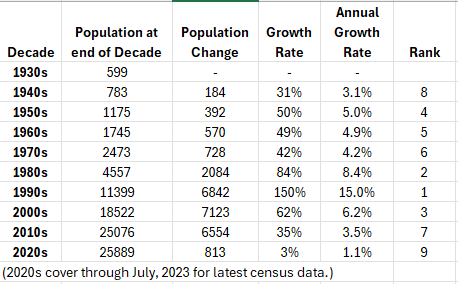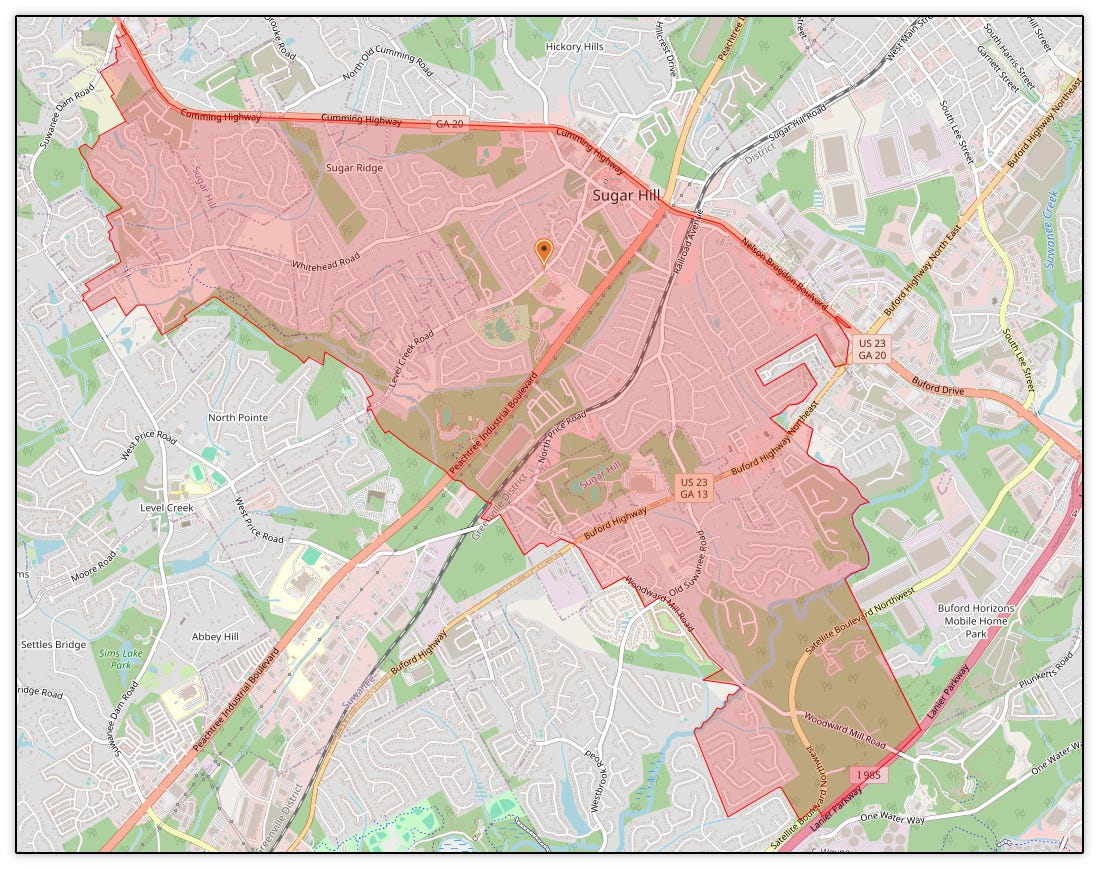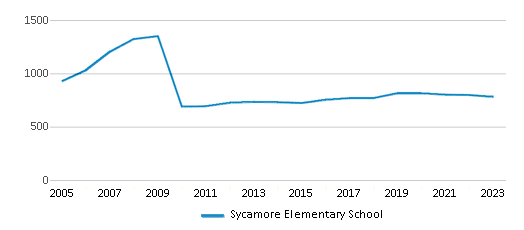Sugar Hill is Growing Slower Than Ever
Despite perception, Sugar Hill's population growth rate is at its slowest in the city's history. Meanwhile, the schools are seeing falling enrollment.
A common refrain we hear is Sugar Hill is experiencing explosive growth. While that was absolutely true 20-30 years ago, the previous decade (2010s) was the third slowest growth year over year in the city’s history.
The slowest year over year growth decade? The one we’re currently living in - and it’s not particularly close.
Population Change
The City of Sugar Hill was chartered in 1939 which means there’s 9 decades of census data to view to see how the city has grown over its 85 years of existence.
Here’s how the city has grown through the decades:
That’s likely a shocking truth to most - that Sugar Hill is growing so slow. The headlines would have you believe that Sugar Hill is actually in its largest growth period in history. In fact, if Sugar Hill continues to grow at 1.1% through the 20s, in the decade the city will add just around 3,000 new residents. The lowest number since the 80s.
What about our surrounding neighbors since 2020 - reminder that Sugar Hill grew at 3%? Suwanee grew at 12%. Buford - notable for extremely limiting residential growth because of its school system - grew at nearly 9%. Cumming grew at an astonishing 38%. Flowery Branch grew at 29%. Our nearest neighbors grew on the low side 3 times the rate that Sugar Hill and over 12 times on the high side.
School Enrollment
One of the common stated concerns is school overcrowding. Sugar Hill is made up primarily of the Lanier Cluster of Gwinnett County Public Schools. The other cluster that serves the city is the North Gwinnett Cluster. Since all of the Lanier Cluster schools are within the city limits of Sugar Hill, they’re the best barometer for us even though a significant portion of the enrolled students at each school live in unincorporated Gwinnett County. School enrollment data taken from this source.
Lanier High School
Lanier High School opened in 2008, having been split from North Gwinnett High School due to the explosive growth of not just Sugar Hill but of the entire county during the 1980s and 1990s. Student enrollment peaked in 2021 but has remained largely steady since 2019. The school has an entire fourth floor that has been unfinished since its opening in 2008 in anticipation of growth.
Sugar Hill Elementary
Sugar Hill Elementary, perhaps more than any other school, would be impacted by the growth in Sugar Hill since the primary location of growth in the city has been in its district over the last several years as it serves our downtown residents. Below is a map of the area Sugar Hill Elementary serves.
And here is its enrollment data going back to 1987. This shows a fairly consistent enrollment of around 1,100 students for about the last 15 years with a fairly consistent downward trend since 2015.
Sycamore Elementary
The other school that would be impacted by the growth in downtown on the north side of Highway 20 would be Sycamore Elementary.
The enrollment data for Sycamore goes back to 2005. Sycamore reached a peak in 2009, which was the time that White Oak Elementary opened and many students were redistricted from Sycamore to White Oak. Since that time, Sycamore saw steady but slow growth to a new peak in 2019 and has been on a minor downward trend, mostly holding around 750 students.
White Oak Elementary
White Oak Elementary opened for the 2008-2009 school year to relieve the pressure of the growth to Sycamore Elementary that occurred during the 1990s and 2000s. White Oak Elementary serves the far northwest corner of Gwinnett County.
Enrollment peaked at White Oak in 2015 at around 850 students and has been on a steady decline since.
Lanier Middle School
The opening of Lanier Middle School coincided with the opening of Lanier High School. All three elementary schools in the Lanier Cluster feed into Lanier Middle School. Like the rest of the Lanier Cluster, Lanier Middle School’s enrollment has been steady to a slight downward trend in the last decade.
The North Gwinnett Cluster serves small portions of the City of Sugar Hill, mostly on its western and southern extremes.
Riverside Elementary
Riverside Elementary is located in unincorporated Suwanee near Settles Bridge Park off Johnson Road. The much of its northern half of its district is in the city.
Enrollment at Riverside Elementary peaked in 2009 and has been on a steady decline since.
The other elementary schools in the North Gwinnett cluster are Roberts, which serves primarily the City of Suwanee with just a sliver of the southern side of Sugar Hill, Level Creek which serves primarily unincorporated Suwanee and the Moore Road area of Suwanee, and Suwanee Elementary which serves the western half of Suwanee.
North Gwinnett Middle School
North Gwinnett Middle School is the sole school from the North Gwinnett Cluster that sits within the city limits of Sugar Hill, but primarily serves the Suwanee area.
Peak enrollment for North Gwinnett Middle School occurred around 2017 and has slightly declined to hold steady at around 2,300 students.
North Gwinnett High School
North Gwinnett High School is located in the City of Suwanee and has the same service area as North Gwinnett Middle School. North Gwinnett High School has a long history dating back more than a century when it was known as Suwanee School in the 1890s. Enrollment had been on a steady increase almost reaching its pre-Lanier peak in 2019. After a huge runup in student enrollment from 1995 through 2009, enrollment has held steady at around 3,000 students for nearly a decade.
What does this mean for our schools? We meet regularly with our Lanier Cluster principals. I can say, without a doubt, that these folks are amazing educators and love both their students and our community. They also, of course, have concerns over growth - both positive and negative growth. Positive growth comes with challenges of classroom space and hiring teachers, something that hasn’t faced our schools in a decade. Negative growth comes with the challenges of loss of staff and resources for the students that remain.
What attracted many families in the 1990s and 2000s to the North Gwinnett area was the stellar reputation of the school system. While the school system maintains that reputation, as growth slows, the school system will have to adjust to a declining enrollment likely for the foreseeable future.
In the next article we’ll examine the city’s growth via housing stock and development, including rezonings, annexations and permits going back to the 1980s.
Part of being a Strong Community is having a diverse number of reasons for people to both locate and stay within the community. Schools attracted families to this area. As the population ages and the general trend towards less children amongst millennials and zoomers than prior generations, our community will have to adapt to remain strong and find more reasons to love where you live.
















